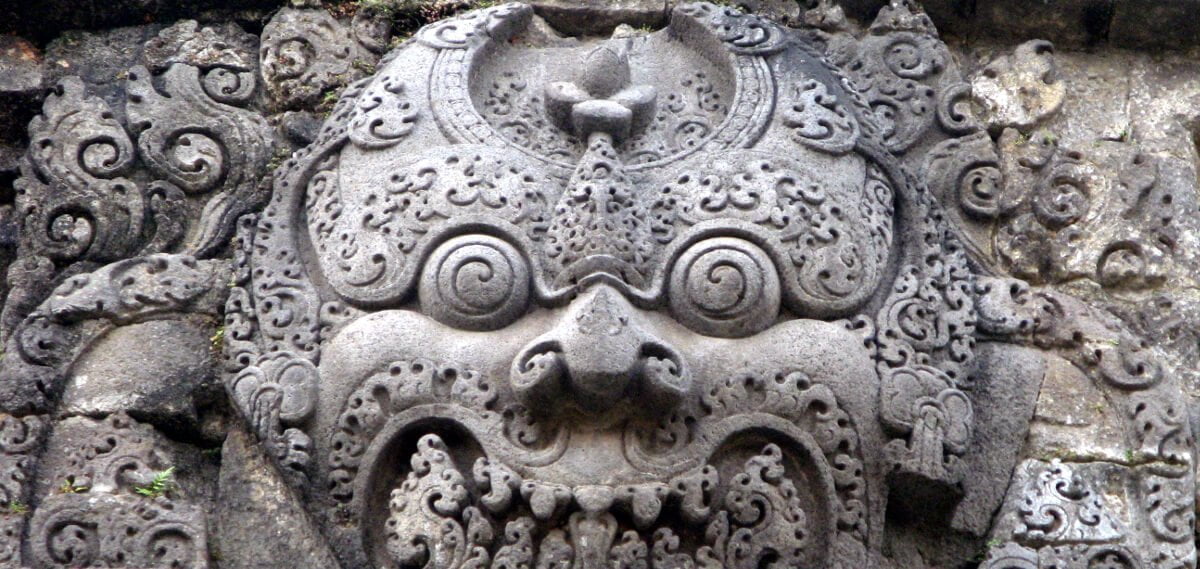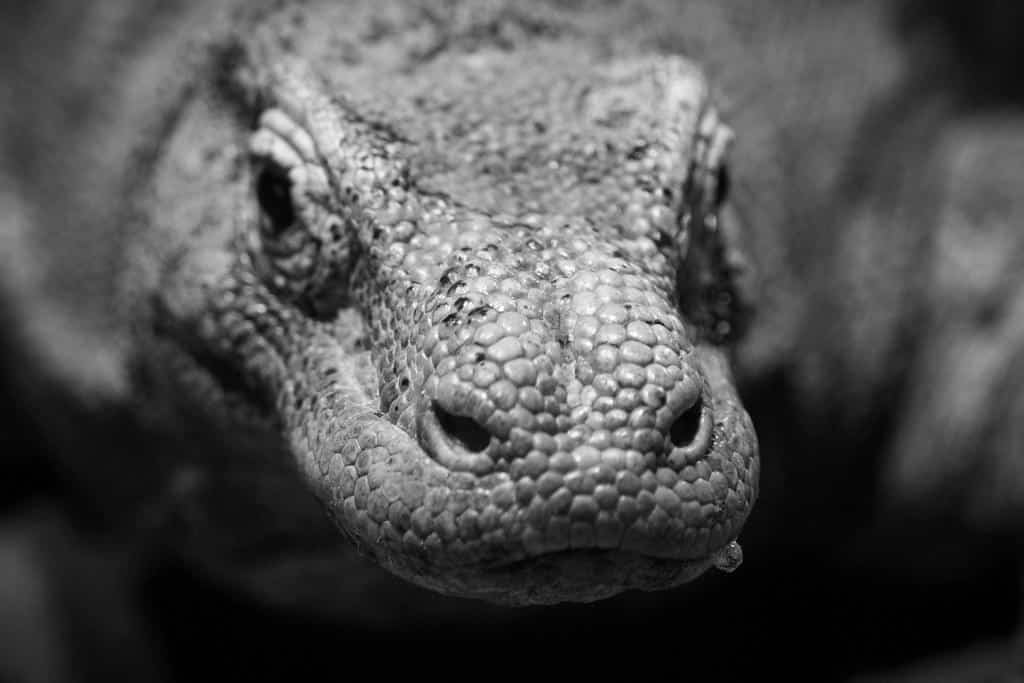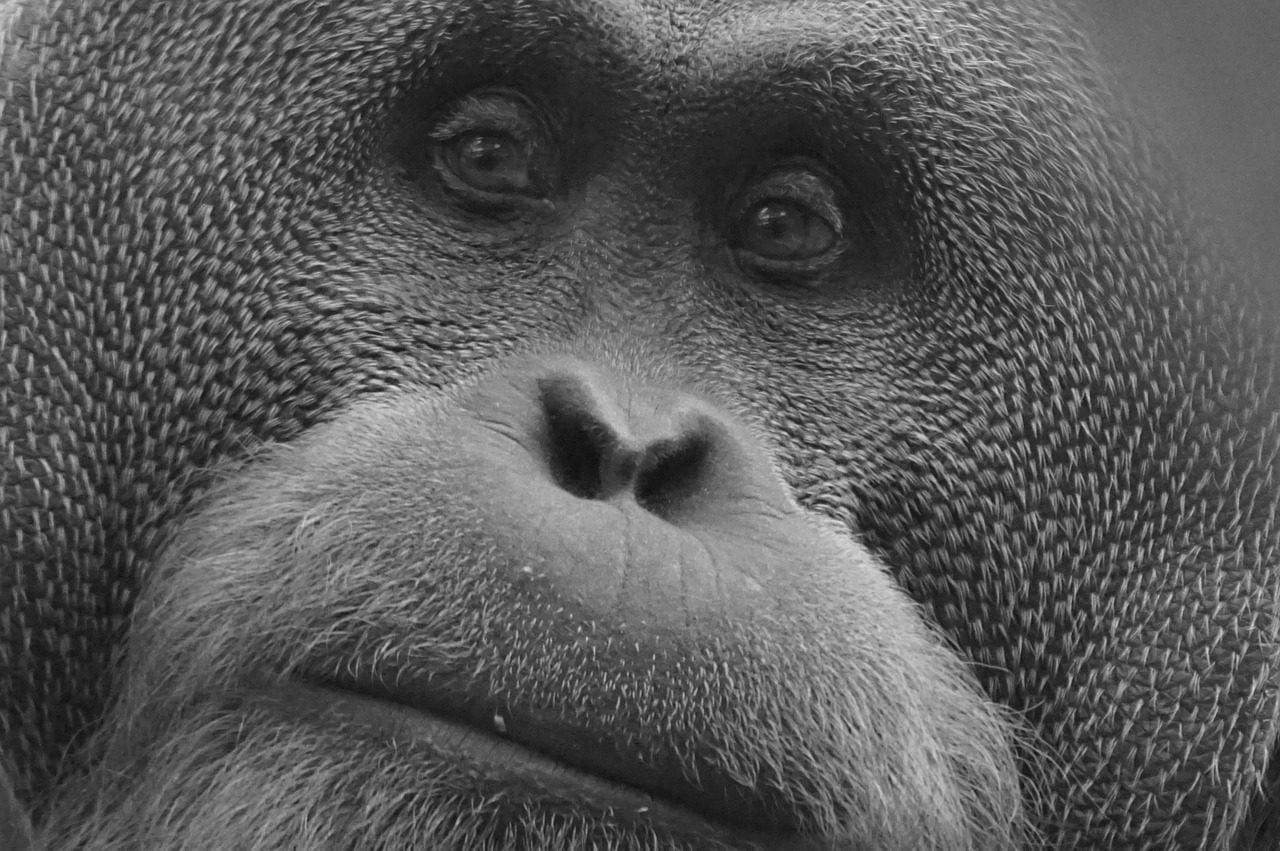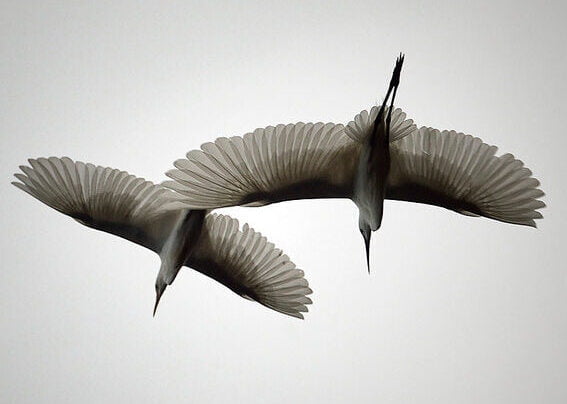The tradition of animal sacrifices in Bali and the mythological origins source from the records in palm-leafs and Hindu literature.
In this Article
Animal sacrifice or bali in Sanskrit, exist in almost all cultures. From Hebrews to Greeks and Romans (Lustratio), Ancient Egyptians (the cult of Apis) and from the Aztecs to the Yoruba. These sacrificial rituals are named and patterned differently for different religions, such as Korban for Judaism, Dhabihah for Islam, Bali for Hinduism. The sacrificial animal may be a sheep, a goat, a pig, a horse, a camel, a buffalo or a cow.
ANIMAL SACRIFICES IN BALI –
Gods, blood and ritual
Watching a Cockfight in Bali made us aware that Balinese gods and goddesses take on terrible forms and want to eat flesh at times.
MYTH: On the creation of Bhatara Kala or Durga
According to the Lontar Kalatattwa, Kala was appointed by Siwa ‘to be the god of all demons, horrible though he might be, he is in no sense a figure of unmitigated evil, but rather has both negative and positive aspects. Hie is none other than the son of Siwa and Uma (Parvati), and has been appointed by them to his duties.

The Kalatattwa lontar text relates that the gods Brahma and Wisnu found the sperm Siwa had shed in his desire for Uma.
TThe ocean was moving violently where it fell and the two gods performed yoga to determine the cause. Suddenly the sperm gathered together and took the form of a giant of terrifying form. Brahma and Wisnu were so frightened when they saw him that they ran away.
The gods became angry and attacked the giant, raining arrows on to him. Finally he was challenged by Siwa himself, whereupon the monster replied that he did not want to harm anyone but only wanted to know who were his father and mother.
Siwa tells, him he must first break his right tusk, and then he will know. Thus Kala learns that his father is none other than Siwa and his mother Uma.
Both parents grant their son boons. Siwa announces that his gift to his son is that all that he encounters will bring success and that he will have control over all living creatures, be Sakti, and be able to kill anyone and also to bring anyone back to life.
Uma instructs her son that he is not to wander around aimlessly but must enter the villages of human beings and stay in the Pura Dalem, the temple of death, where he is to have the title ‘Durga‘. Uma also tells her son that when he breaks his tusk he will have the title ‘Hyan Kala’, given by his father Siwa, and become the god (dewa) of all demons, ogres, giants, plagues, pests, poisons and magic.
By breaking his right tusk Kala will assume his rightful position as the son of the creator god and goddess. Kala then asks his mother what is to be his food. She replies that he is – welcome to eat any person who sleeps until evening or wakes up after sunset, or any baby that cries at night because it is frightened by its parents, or people who read kidun, kakawin or holy teachings in the middle of the road.
Siwa then adds to Kala’s duties and rights, informing him that he has the right to penetrate every village and to guard all parts of the village and all human and animal life. Every year at Sasih Kasanga (the ninth month), however, Kala must
‘mete out punishment to all people who do wrong, evil people, those who break the laws, those who do, not behave in accordance with etiquette, true teachings and religion’.
Kala is further informed by Siwa that he has the right to cause plagues of incurable fatal diseases and to bring disaster to all communities as punishment from Siwa-Raditya (Siwa in the form of the sun god).
Those killed by the plagues and disasters are to become the food of Kala and his deputies.
If there is a king or leader on earth who begs the gods for mercy and asks for life to be restored to earth, however, he must pay compensation to Kala and the gods by means of offerings and sacrifice.
Because of this, human beings must know how to perform the necessary offerings, which include eight yajna. This text mentions seven kinds of sacrifice. Balinese usually refer to five, omitting Siwa yajna and a Svamedha yajna.
These yajnas, the lontar explains, are called the seven sacrifices and constitute the means of creating peace in the world.
Siwa then goes on to explain the necessary offerings and procedures for each ritual to Kala in great detail. The importance and function of these rituals are made perfectly clear. They are the means of ensuring safety, well-being and peace for humankind.
It is also explicitly stated that they represent compensation to Kala and the gods. Kala has been given the right by his divine father to devour all sinners, and those who wish to be spared this fate must provide Kala with alternative food.
Provided human beings meet these requirements for giving Kala and the gods appropriate sacrifices and offerings, the result will be nothing less than miraculous. Siwa tells his son:
“If people act in that way [make the required offerings], you may change form from a frightening shape to a peaceful form (somyarupa), with all your deputies, and bring an end to your cruelty and to all punishments; you can obtain purification from Siwa and Buddha high priests, which can remove all defilement in yourself and outside yourself; and indeed you [with your deputies] will return to become gods and goddesses and will be returned to be one with your mother and father and enjoy life in heaven.”
Kala’s duty is to punish miscreants and sinners, who become his rightful prey or food. Thus he is not forbidden by the high gods to eat humans, but his voracious appetite must be controlled. The offerings made to him, as the text of Kalatattwa also makes clear, are compensation, a substitute for the human beings he would otherwise devour. Accordingly, Siwa instructs Kala during the dangerous ninth month to punish the whole world with plagues, thus providing himself and his deputies (the bhuta kala) with a plentiful supply of human meat. The way to save the world from destruction, Siwa explains, is to make offerings and sacrifices, that is to say, to provide Kala and his deputies with substitute meat.
MYTH: On the creation of the Bhuta Kala or Why there is need for offerings
Siwagama Lontar tells this myth:
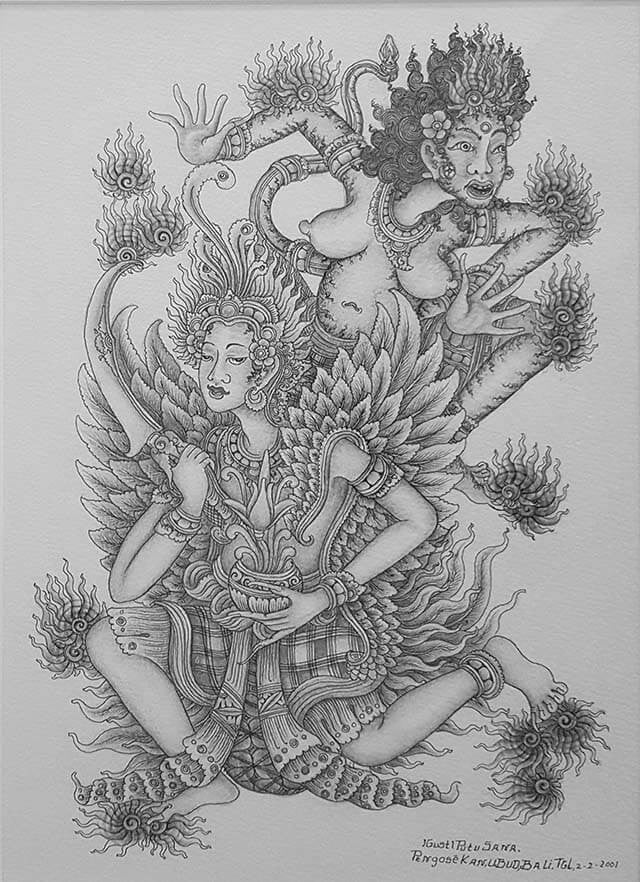
Tt some mythic time after the birth of Bhatara Kala. The story begins with Uma walking through mountain forests looking for her husband Siwa, whom she has not seen for some time. She comes across her son, Kumara, who is also searching for Siwa. When she asks her son why he has not visited her for a long time, Kumara replies that he would much rather meet with his father, as he owes his father ten times more than he owes his mother.
Furious, Uma is ready to kill her son, demanding that he return to her his blood, flesh and skin, which came from her, but she is stopped by Siwa.
Uma is then cursed by Siwa to descend to the earth as Durga. Later Siwa curses himself to take the form of Kala Rudra and goes to earth in search of his wife.
Meanwhile, Durga has transformed into five Durgas, one for each direction (the four cardinal points and the center). Kala Rudra meets each of the five Durgas in turn to engender all kinds of demonic and destructive entities in each direction:
[…] in a moment Bhatara Guru [Siwa] cursed himself to become Kala Rudra of monstrous appearance; he left to enter all the villages, wherever was the place of Bhatari Durga. Bhatari Parwati (Durga) was found while in five forms (Pancarupa), in the centre of the cemetery […] namely Sri Durga in the east, Rajnl Durga in the north, Suksmi Durga in the west, Dhari Durga in the south, and Dewi Durga in the centre.
They were thinking, the five wanted to bring about the destruction of the world and perform evil. Suddenly Bhatara Kala Rudra arrived and paid respect to the Five Durgas. They all requested his touch. The request of the five Durgas was fulfilled, and together they became one.
Then Bhatari Sri Durga created Kalika Kaliku, Yaksa Yaksi, Derjen, and thousands of demons.
Thus was the origin in that cemetery, which can be called ‘Pancaka’, because it became the place where resided Bhatari Panca Durga (Five Durgas) in the form of ArdhanareSwar (united in one body female with male) with Bhatara Kala Rudra.
At the time when they were still at the crossroads they assembled and created Catur Bhuta and other bhuta kalas. When they entered the public meeting-hall, the Bale Agung, the name Bhatari Durga was changed to become San Kalika Maya, and Bhatara Kala Durga changed his name to Sanutisarana; there they came together, then appeared many bhuta kalas they created.
The monstrous parents and their monstrous offspring then began to devour humankind and destroy the world.
Meanwhile Brahma, Wisnu and ISwara were puzzling over how they might save the world from Siwa in his terrible form:
The Trisamaya were very worried about the departure of Bhatara Guru, who returning to Original Form already had cursed himself to become Kala Rudra with the very frightening countenance. The three of them discussed what could be done so that Bhatara Guru would return and change form to become gentle (somyarupa), return again as Siwa.
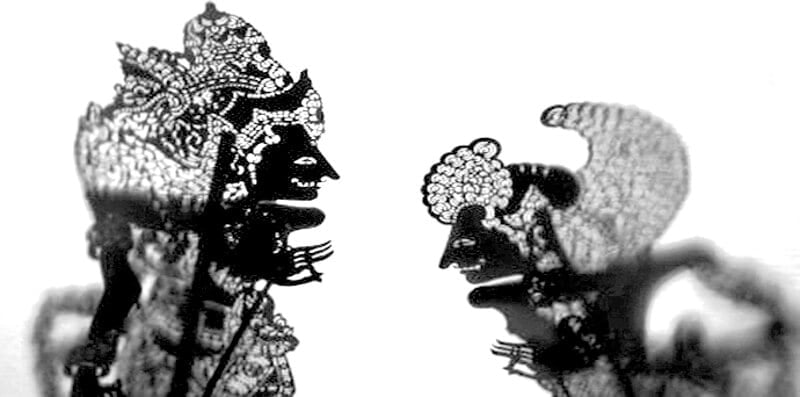
It is said they made a wayan kulit; leather was carved, they imitated the face of Bhatara Guru with the gods, and at the same time […] they caught the image of the Bhatarl [Durga]. After that, Sarj Hyan Trisamaya’ went down and looked for the place where Bhatara Guru was in order put an end to his desire to eat humankind. San Hyan Kala Rudra was encountered together with Bhatarl Durga, sitting in the public meeting-hall, the Bale Agung. Kala Rudra was disguised with the name San Jutisarana, while Bhatarl Durga was named San Kalika Maya.
Recognizing the god and goddess in their disguise, the Trisamaya informed the king of the country of their doings and instructed the king of the region to prepare special offerings:
The king of Galuh was ordered to make ready and arrange offerings, namely cam Pancasia, complete with the blood of meat, raw sate, threaded sate, bitter sate […] to be led by Sarj Maha Pandita (priests), so that the country of Galuh would not be destroyed by Sarj Kala Rudra. The king became the originator of cam in the world of Java.
Having instructed the king, how to prepare the appropriate offerings; Brahma, Wisnu and ISwara then themselves staged the performance depicting the actions of Kala Rudra and Durga:
Hyan Trisamaya built a stage and installed a curtain to give a wayan performance.
Bhatara ISwara became a dalan, flanked by Bhatara Brahma and Bhatara Wisnu, together with drums, stringed instruments, and with songs accompanied the beautiful story. The journey of the couple became the story of a play.
Sarj Hyan Kala Rudra and Bhatarl Paflca Durga became the origin and source of the existence of way ay in Java, watched by many people.
The results of these efforts by the Trisamaya are nothing short of miraculous, and lead to all the dangerous destructive forces present being transformed and restored to their divine forms:
The heart [literally ‘liver’] of Bhatara Guru became gentle after watching the drama that was performed by Sarj Hyarj Ifiwara. At the same time the bhuta kala were instructed to enjoy the offerings.
The hearts of Bhatara Guru and Bhatarl Durga were ashamed. The offerings of the Pancasia cam from His Majesty the King were already received. In that place the deputies, namely bhuta kala and dgnSn, were well satisfied, and they changed form to become gentle (somyampa) […]
The bhuta kala were made to disappear, ordered to return to heaven, to return to the Siwa form. San Hyan Kala Rudra left with Bhatarl Durga, together with their servants.
Variant: On the creation of the Bhuta Kala or Why there is need for offerings
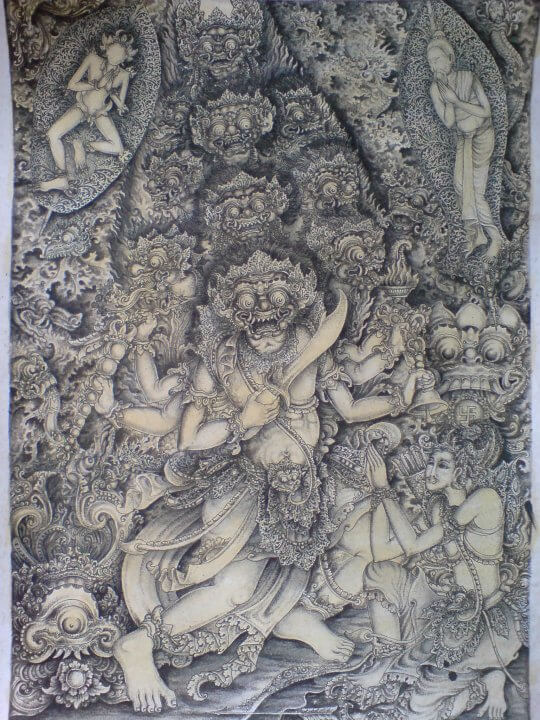
Stephen Michele tells a similar story, from the creation of the bhuta kala given to him by a high priest (pedanda) from Batuan:
It is told how Bhatari Uma penetrated into the jungle, the mountains, wanting to meet with Bhatara Guru. Suddenly she met San Hyai) Kumara, who asked his mother where was Bhatara Guru. The Bhatari answered, “How is my son, Sarj Kumara?” “I want to find where Bhatara Guru has gone”, answered San Kumara. “Respectful greetings, Excellency, Hyan Mother, your servant wants to pay homage to His Excellency Bhatara Guru – as a form of payment by your servant
for the huge debt your slave owes him.”
Said the Bhatari, “Oh, oh, my Kumara, your heart is devious, you never want to visit Mother.
You never come to pay your respects to me. You have a deceitful heart. You don’t know the original source of your body. Blood, flesh, and your skin were created from your mother’s ovum.
Your muscles, bones and marrow originated from your father’s sperm.”
Thus was the reply of Sarj Hyarj Kumara, “If it could be weighed, ten times greater is the debt of this slave to his father than to his mother”.
The Bhatari was very angry, “Hay, may you be killed, Kumara! Return your blood/your flesh and your skin to me!” In a second she had taken the form of Durga.
Then Bhatara Guru intervened, “You are cursed to be Berawi Durga, you will now devour everything!”
Bhatari Durga was cursed by Bhatara Guru and in a moment she took the form of Pafica Durga.
Later the Bhatara felt disgusted with himself and cursed himself to become Kala Rudra. He entered all the villages, searching for the place of Bhatari Durga. Finally he met her in the cemetery and at the crossroads, in five places. Sri Durga in the east, Rajni Durga in the north, Suksmi Durga in the west, Dhari Durga in Daksina, and Dewi Durga in the centre. [Here follows a long list of names of the bhuta kala they created.]
They then entered the Bale Agung. Bhatari Durga was then named San Kalika Maya. Bhatara Rudra was named San Jutisarana.’
Siwa and Uma are the creators of all destructive forces in the world, including Bhatara Kala, the bhuta kala; human witches, and plagues. Siwagama reveal also how knowledge of witchcraft and sorcery was acquired by human beings via the teaching of the Ragda, daughter of Uma and Siwa; and how plagues emanated from the union of Uma’s foot with Siwa’s sperm. Ragda is sometimes Umas and Siwas doughter, sometimes, she is seen als Uma or Siwa themselves.
Accordingly, it is Siwa and Uma in their demonic form who can provide protection against these forces, and it is they who must be persuaded by rituals and offerings to resume their beneficent forms so that humankind will be saved.
This myths are told by Michele Stephen. In: Returning to Original Form A Central Dynamic in Balinese Ritual. In: Bijdragen tot de Taal-, Land- en Volkenkunde 158. 2002.
Shiva or Siwas many names:
Eka Dasa Rudra – Siwa Rudra – Kala Rudra – Sanghyang Widi Wasa
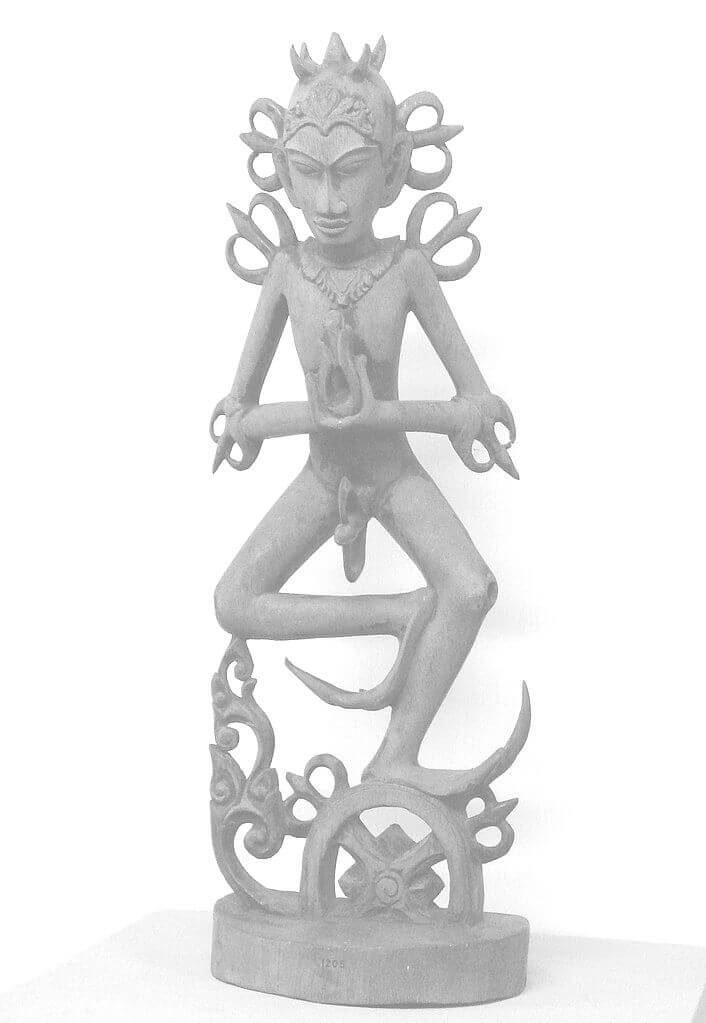
Caru, and the bhuta yajna in general, of which the Eka Dasa Rudra is the pinnacle, aim to ‘placate the demons’. Stuart-Fox explains the meaning of the term ‘Eka Dasa Rudra’ as the dual nature of the high god Sarj Hyarj Widi, whom he identifies with Siwa:
Rudra, meaning ‘howler’, is a god associated with wildness and danger, the Vedic antecedent of Siwa with whom he later became associated. Often one meets the compound terms Siwa Rudra or Kala Rudra (Kala is the destructive aspect of Siwa).
Since Siwa is another name for Sanghyang Widi Wasa in the Siwa-siddhanta sect of Hinduism which became dominant in Bali, these terms refer to Sanghyang Widi Wasa in His terrifying state, the source of wild and violent energy.
Other names are Acintya, also Atintya (Sanskrit: “the unthinkable”, “the inconceivable”, “he who cannot be imagined”) and also Tunggal (Balinese: “Unity”). He is equivalent to the concept of Brahman, and is the Supreme God in traditional wayang (shadow puppet) theatre. He is also known to most modern Balinese as Sang Hyang Widhi Wasa, also Sanghyang Widi Wasa (the “All-In-One God”), a concept introduced by Dang Hyang Dwijendra.

I Nyoman Toya depicted a mythical story of the God Siwa who sent his wife, Durga, to earth to get fresh cow’s milk to cure his illness. When Durga met a cow herder, she off#ered her body to him in exchange for the milk. She went back to the heavens and presented her husband with the milk. He was happy but he wanted to know how his wife got the milk, suspecting her deceit. Since Durga refused to confess, Siwa called the God Gana to tell him the truth. As Gana was telling what actually happened for Durga got so angry she turned herself into a demonic being (Durga Murti).
Bali- dana, animal sacrifice for Goddess Kali or Durga
The Sanskrit term used for animal sacrifice is ‘bali‘, this means “tribute or offering” to the Gods, which are generically animal or vegetable oblations. Hindu animal sacrificial rituals are mostly associated with Shaktism, where the female nature is worshiped in the form of Kamakhya or Kalika or Kali, Durga and other different forms of Devi Sakti.
The Kalika Purana, is a religious text belonging to the Puranic literature (10th-11th century AD), celebrating the power of the divine feminine in her various manifestations.
Chapter fifty-five writes about – Offering Sacrifice of the Goddess or bali-dana
The Lord said :
There after an adept should perform ‘ badiddna ’ (offering sacrifice), which causes much delight to the goddess. An
adept should always satisfy Ganesa with sweet-meat, the sun with ghee, Siva with music, dancing and instrumental music,
Visnu with observance of austerity, and Cantjika with balidana.
Kalika Purana distinguishes sacrifice or “bali” from great sacrifice or “maha- bali”. Chapter 55 says also that worshippers of Kali who sacrifice the flesh of eigth varieties to her become accomplished.
The eight varieties are counted as –
(I) birds,
(II) tortoises,
(III) allegators,
(IV) nine species of animals —
(a) the he-goat, (b) the boar, (c) the buffalo, (d) the big lizard, (e) the s’osa (crow ?), (f) the yak, (g) the spotted
antelope, (h) the hare, (i) the lion;
(V) the fish,
(VI) the blood of one’s body,
(VII) the horse and
(VIII) the elephant.
Man are mentioned specially in addition to the eight varieties of bali.
The Hymn to Kali, Karpuradi Stotra, Verse 19, states:
“O dark one, wondrous and excelling in every way, becomes the accomplishment of those worshippers who living in this world freely make offering to Thee in worship of the greatly satisfying flesh, together with hair and bones, of cats, camels, sheep, buffaloes, goats and MEN.”
~ Hymn to Kali, by Arthur Avalon (Sir John George Woodroffe), 1922, at sacred-texts.com
Contrary to popular perception that the reference made was to the ritual killing of animals. A commentary by a Kaula, Vimalananda Svami, which Woodroffe only partially translates, claims these animals represent the six enemies with the goat representing lust, the buffalo anger, the cat greed, the sheep delusion, the camel envy, and the last one – man representing pride.
The Kalika Purana further states:
Birds, tortoises, allegators and nine species of deer— such as. the he-goat, the boar, the buffalo, the big lizard, the sosa (?), the yak, the spotted antelope, the hare, and the lion; fishes, the blood of one’s own body ; and in absence of these sometimes horses and elephants – these eight varieties are regarded as ball to the goddess
He-goats, iarabhas (?) and men are respectively counted as bali (sacrifice), mahabali (big sacrifice) and ati-bali (exceedingly big sacrifice)
After the adept has bathed the sacrificial animal he should worship the goddess with flowers, sandal paste and incense repeating the sacrificial mantra again and again.
The ritual requires slaying of the animal with a single stroke (Jhatka). Kalika Purana also depicted some tantrik practices, like the use of the panchamakara (meat, wine, fish, parched grain and sexual intercourse) in a ritual context, which were forbidden in mainstream Indian Hindu practices.
The three methods used by Hindus to kill an animal are Jhatka (decapitation with a single blow), piercing the heart (with a spike) and asphyxiation (squeezing the throb of heart, leading to death from lack of oxygen).
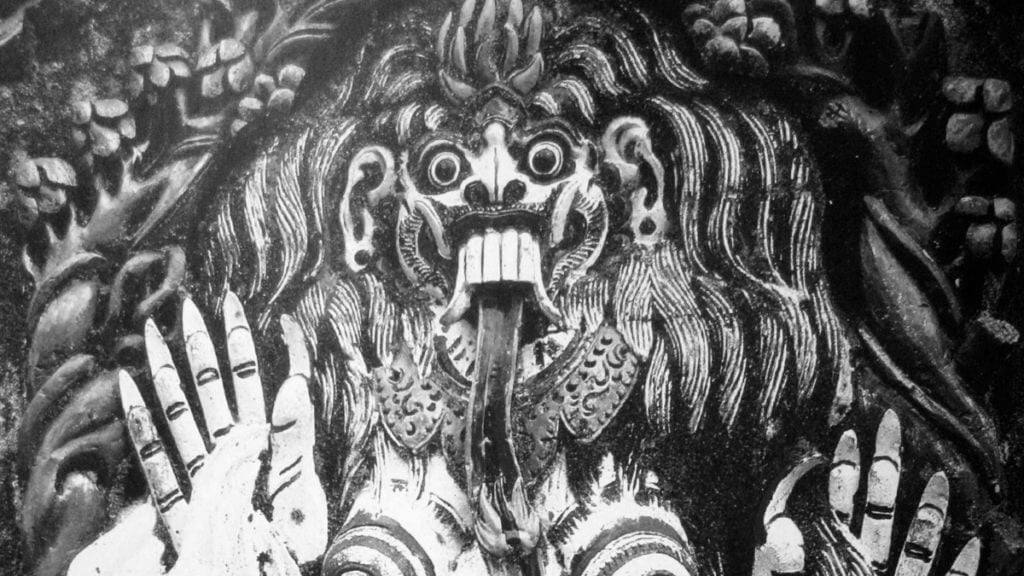
THE BLOODTHIRSTY GODDESS
As stated by Bhuyan Rashmi Rekha, in The Portrait of the Goddess in the Kalika Purana. In: IOSR Journal Of Humanities And Social Science. Volume 22, Issue 10, Ver. VII. 2017. www.iosrjournals.org
In the Kalika Purana the Goddess Kalika is portrayed as bloodthirsty goddess whom a devotee can propitiate by sacrificing human and animals. Blood sacrifice is called as the best of all the offerings to the goddess.
Chapter 65 narrates an adept should perform bali dana which causes much delight to the goddess.
An adept should always satisfy Candika with bali dana.
Chapter 67 of the text, called Rudhiradhyaya means blood chapter, is dedicated to the items and procedure of offering blood sacrifices to the goddess. The items include birds, reptiles, fish, animals, human and even one`s own body.
Here human sacrifice is considered as the greatest of all the sacrifices (maha bali).
Through offering sacrifices a devotee can attain liberation and the kings can destroy enemies. In Rudhiradhyaya the goddess is addressed by various names – Candika, Mundamala, Durga, Bhairavi and Kamakhya.
In India it is the Mother Goddess alone who need blood sacrifices. Mother Earth, very nature is arid and dry because through her monthly menstruation she loses her generative power and so needs to regenerate it constantly by absorbing blood. In the tribal societies of ancient India the regeneration of the vital principle is realized through a ritual offering of blood.
Even the terrible, man-devouring Durga as described in the Purwa Bhumi Kamulan has the power to transform into a benevolent, protective
figure if she is given the right worship and proper offerings:
And the God Kala had to eat,
And the Goddess Durga also
Fermented liquor, flesh and rice:
Much food there was, and of all kinds.
Too many to give each a nameThey looked with joy upon their feast,
Too many to give each a nameWorship was the result of it,
O f mankind in the Middle Sphere
Being eaten by God Kala,
And by the Goddess Durga, too.
And then a covenant they made:
…The Goddess Durga eat him not;
From his Ten Evils he be freed.
~ Hooykaas
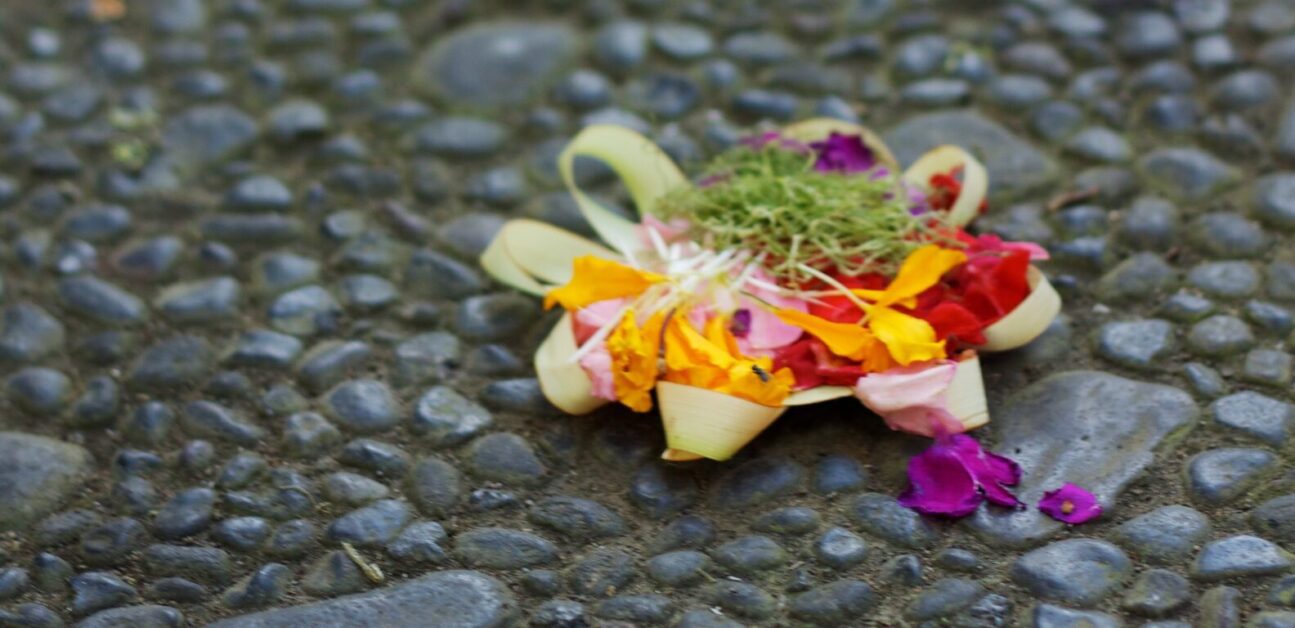
BALINESE OFFERINGS
Balinese offerings are not always things of beauty, like the canang sari– white lime, red betel-nut and the green sirih or gambier plant – each representing a major Hindu God of the Trimurti – Shiva, Brahma and Vishnu. Or flowers that symbolize sincerity and love: white petals in the east of the little box for the God Iswara; red for the fiery Brahma in the south; yellow flowers – usually jepun, or frangipani – for the God Mahadeva in the west; and blue or green for cool Vishnu in the north. On top there is a small-denomination banknote or coin that completes the sari – the selfless essence – of the offering.
As told in the article: Food of Bali Ritual, Hindu community in Bali believes that food plays an important role in ritual and worship. Food offered to the gods called “Prasada” which in Sanskrit means “mercy,” or grace.
Food in Balinese ceremony is often described as a feast for Gods and often described literally as a celebration for the gods and spirits. In the discipline of meditation, they offer food to Gods before enjoying the food served. That means spiritually most Hindus in Bali regards the food has a value of karma that must be removed and not be involved while being eaten.
The Balinese have strong spiritual beliefs. Food is often used as offerings to the gods and frequently seen in temples and holy places in Bali. Serve is offer daily to the gods and spirits, particularly for Goddess of rice (Dewi Sri) whose temple stood in the middle of flooded rice fields to ask for blessings.
Preparing offers to the gods is part of meditation of strong reflection- Yajna.
Yajna
For Balinese Hindus, yajna, lies in various types of oblations: billowing clouds of incense, spreading fragrance of flowers and incense, mantras of worship chanted by priests, vocal of psalmody, lively gamelan music, and wayang plays and various other religious art attractions.
In Indonesia, including Bali, the Pañca Yajña is described in the form of religious rites led by priests, like worship, offerings, sacrifices andritual sacrifice.
The Bhagavad Gita outlines the important rituals for Hindu people:
“When he created creatures in the beginning, along with the sacrifice, Prajapati [lord of creation and protector- Brahma, Vishnu, Shiva, Agni, Indra, Vishvakarma, Bharata, Kapila and many others.]
said; ‘May you fruitful by this sacrifice, let this be the cow which produces all you desire. (11)
‘You should nourish the gods with this so that the gods may nourish you; nourishing each other, you shall achieve the highest good.
(12) ‘For nourished by the sacrifice, the gods will give you the pleasures you desire. The man who enjoys these gifts without repaying them is no more than a thief.”
~ Gita, 1994, pp. 15-16.
The Balinese Hinduism is based on the concept of Tri Hita Karana, the belief that there should be balanced relationships between man and God, man and all other people, and man and nature. The Balinese rituals are holy sacrifices to the gods that serve as an expression of thankfulness, a cosmological balance, moral improvement, serenity and happiness of life, as well as faithfulness.
Yajna, or holy sacrifices, are made to sustain the balance and the various types of holy sacrifices are each meant to address a particular subject, like:
1. Dewa yajna; rituals for the gods,
2. Pitra yajna; rituals for ancestors,
3. Rsi yajna; rituals for priests or saints,
4. Manusa yajna; rituals for human being,
5. Bhuta yajna; rituals for environment.
Blood offerings – Bali, Caru Sacrifices or Bhuta Yajna
Animal sacrifice, called bhuta yajna in Sanskrit and caru in Balinese, is widely practiced in Bali.
Hinduism came to Bali 1,200-1,500 years ago. At that time, the practice of animal sacrifice may have been more prevalent in India than it is now. According to Vamadeva (ancient Vedic teachings), animal sacrifice occurs today not only in Bali but in the Himalayas, Assam and the northeast of India, as well parts of Orissa and Bengal, Nepal and a few places in Punjab. Many Indian Hindus substitute animal sacrifice with vegetables, flowers, incense, fruits etc. today.
While most Indian Hindus oppose animal sacrifice (and eating meat) based on the prevailing Hindu principle of ahimsa, nonviolence, only a few Balinese Hindus seem to share this view. From students to high priests, nearly everyone I interviewed endorsed animal sacrifice, believing it leads to the attainment of a human birth for the animal.
~ Rajiv Malik. The Reality of Animal Sacrifice.
The ritual process of “feeding” dangerous destructive forces like Durga and Kala Rudra [Siwa and Uma in their demonic form, or as known as Barong and Rangda represented in Masked dance performances]- is called caru. Caru offerings constitute also offerings to the bhuta kala. This various sacrifices usually precede all other types of ritual, whether they be for the gods, for ancestors, for human beings, or for teachers.
According to Donder I Ketut, [The essence of animal sacrifice in Balinese Hindu ritual: Discourse around Theological, Philosophical, Mythological, Ritual and Scientific Phenomena. 2012.] the palm-leaf manuscripts of yajña in Bali seem to give more emphasis on the implementation of bali rituals, defined as a ritual intended for Bhuta Kala (ogre) regarded as a source of negative energy.
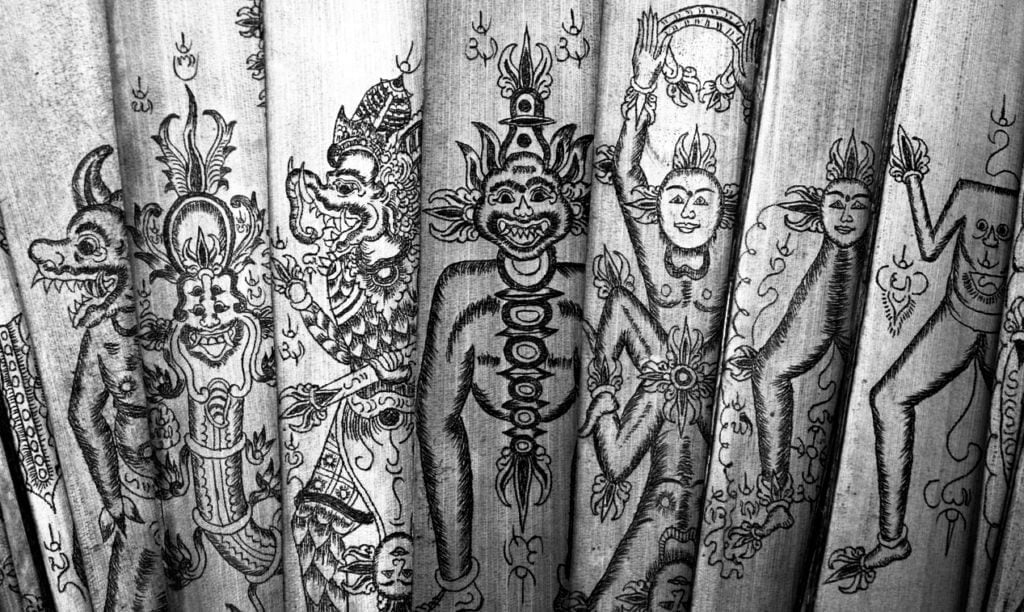
The term bali refers to blood offerings and/or animal sacrifice
Fuller
Implementation of caru, meaning beautiful, or harmonious, is divided into three levels, namely
- nista (small, simple),
- madya (middle), and
- uttama (large)
in perspective of the content of rituals in use.
Most Hindus in Bali believe that ignoring the caru ritual will bring in catastrophe and or chaos. Below is given a summary regarding the caru ritual taken from the palm-leaf manuscript entitled Kramaning Caru. The various kinds of caru rituals listed are ranging from the simple to large scale:
- Caru using chicken of grayish scaly-feathered or brumbun chicken is called Caru Pangruak
- Caru using white chicken is called Caru Dengen
- Caru using red (biying) chicken is called Caru Preta
- Caru using chicken of yellow leg and white feather ( putih siungan) is called Caru Anta Suksma
- Caru using black chicken is called Caru Bicaruka
- Caru using five kinds of chicken ( Pañca Sata) is called Caru Pañca Mahabhuta, or Caru Pañca Sata
- Caru Pañca Mahabhuta plus an eagle-feathered duck and a red-furredand black-mouthed dog (bang bungkem) is called Caru Pañca Sanak
- Caru Pañca Sata plus an eagle-feather duck is called Caru Pañca Durgha
- Caru Pañca Sata plus a strip-necked duck is called Caru Pañca Mabaya
- Caru Pañca Sata plus a white duck is called Caru Nawa Gampang
- Caru Nawa Gampang plus five chickens of different colors as above and in the mid is added with red-furred and black-mouthed dog is called Caru Rsi Gana
- Caru Wisesa uses chicken of five colors where in the middle is added with black duck. Virtue of black duck is equal to black buffalo. Caru Wisesa aims to eliminate the rampant outbreaks of disease or caused by the influence of black magic, Bhuta Kala, or the other
- Caru using a scaly-feathered goose is called Caru Yama Raja, this caru aims to neutralize negative forces when opening a land to build a village, open courtyard, repair a palace, etc.
- Caru Pañca Sata , if added with an eagle-feathered duck and a red-furredand black-mouthed dog is called Caru Pañca Kelud
- Caru Pañca Sata if added with a goat and strip-necked duck is called Caru Pañca Sanak
- Caru Pañca Sata if added with male (non-castrated) pig is called Caru Balik Sumpah
- Caru Pañca Sata if added with a cow is called Caru (Tawur) Gentuh
- Caru Pañca Sata if added with a buffalo is called Tawur Agung
- Caru Pañca Sata if added with three buffaloes is called Pamaligia Bumi Masapuh
- Caru Pañca Sata if added with five buffaloes is called Pañca Wali Krama
- Caru Pañca Sata , if added with 26 buffaloes is called Caru Eka Dasa Rudra, conducted in the area of Besakih Temple
- Caru Pañca Sata if added with 46 buffaloes is called Pamaligia Rebu Bhumi. This ritual is believed to affect up to Tri Bhuana area (Bhur= lower realm as the abode of Bhuta Kala; Bhvah= middle realm, the abode of human, and Svah= higher realm as the abode of gods).
Various rituals in Bali often use animal flesh as an offering that has an almost equal position to flowers in oblations. For example, peras oblation must contain grilled chicken otherwise they are not considered complete. As written in the Rig Veda:
“what is on the grilled meat, oil and the meat itself should not be thrown onto the grass, offer it to the gods”
Bhuta Yadnya is the holy sacrifice meant to maintain the balance between man and nature and is important because it is in nature (the natural world) that bad spirits are believed to most often reside. Bhu literally translates from Balinese to English as the word ‘nature‘. So keeping Bhuta, also known as butakalas or kalas ,(or the bad spirits in nature) from becoming troublesome to man is accomplished by showing respect and give sacrifices. Offerings are normally given to nature beings from the underworld by laying them on the ground. This stems from the belief that demonic beings reside below us. The simplest offering, consist of rice and banana leafs. Among the more elaborate offerings includes blood or flesh collected from sacrificial animals.
“When I ask why chicken is the sacrificial animal of choice, he pauses. … the pedanda begins, because they scratch around in the earth and will eat anything they can find. This makes them suitable for feeding demons but not heavenly deities…”
“Hinduism in Bali is most ancient. Here we practice Tantric Saiva Siddhanta, as opposed to the Vedantic Saiva Siddhanta of India. Most of our temples are tantric, and that is the reason we carry out animal sacrifice.”
~ Lawler Andrew

In classical Indian pictures, she is shown (as the personification of Eternity) trampling on the body of Siva (Time). In one hand she holds the exterminating sword, in another a human head ; a third points downward, indicating, according to some, the destruction which surrounds her, and the other is raised upwards, in allusion to the figure of regeneration of nature by a new creation. Whatever her gestures may import, the image of this goddess is truly horrid, as are the devotional rites performed in her honor. Her wild, hair reaching to her feet, her necklace of human heads, the wildness of her countenance, the tongue protruded from her distorted mouth, her cincture of blood stained hands, and her position on the body of Siva, altogether convey in blended colors so powerful a personification of the dark character which she is pretended to portray, that, what ever may be thought of their tastes, we cannot deny to the Hindus full credit for the possession of most extraordinary and fertile powers of imagination. Kali is the goddess of cemeteries, under which form she is described dancing with the infant Siva in her arms, surrounded by ghosts …and goblins (likewise dancing) in a cemetery among the dead ; her images, under this form, are worshiped by the Hindus as a propitiation against the destructive ravages of the cholera.
Lawler Andrew [Why Did the Chicken Cross the World?: The Epic Saga of the Bird that Powers Civilization. 2016.] elaborated on the local customs:
“We follow Durga and Shiva, who are two sides of the same coin. We worship Durga if we want something magical. She is extremely popular in Bali, and every home worships Her every fifteen days with animal sacrifice. Every hundred years we have to perform the Ekadasa Rudra festival in which more than 200 kinds of animals are offered.”
BLOOD RITUALS

Unlike their Hindu counterparts in India, very few Balinese Hindus are vegetarian or vegan, and sacrificed animals are all on the menu at the ceremonies, like satay, a genuine Balinese delicacy:
Languan satay is made from sea fish, green coconut, spices and brown sugar. This dish is a traditional food from Klungkung, but can be found all over Bali. Sate Languan is served in rituals only one day right after baking (while it is still hot) and usually served with lawar.
Lembat satay is made from meat mixed with grated coconut and spices. Usually use pork, chicken, ducks, and turtles. It is served in rituals and ceremonies.
For ordinary exorcism at temple ceremonies, sacrifices of smaller animals such as ducks, chickens, roosters and baby chickens may suffice. On special occasions goats, dogs, cows, water buffaloes and turtles are also necessary to complete certain rituals and pigs are given as offerings.
Duck, chicken, rooster
The religious belief of Tabuh Rah, a form of animal sacrifice of Balinese Hinduism includes a religious cockfight where a rooster is used in religious custom by allowing him to fight against another rooster in a religious and spiritual cockfight, a spiritual appeasement exercise of Tabuh Rah. The spilling of blood of a rooster is necessary as purification to appease the evil spirits, and ritual fights follow an ancient and complex ritual as set out in the sacred lontar manuscripts.
Pig
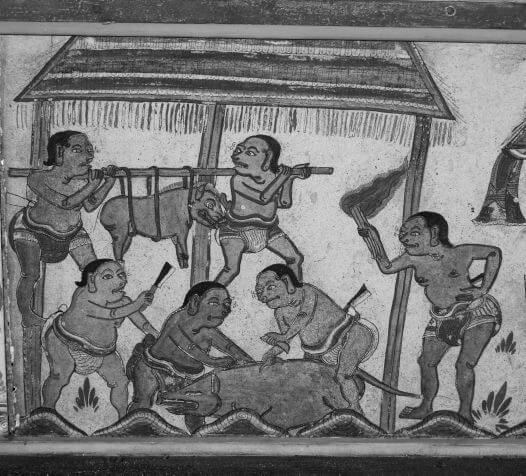
Pigs are slaughtered for a broad range of events such as odalan (temple festivals), otonan (anniversaries of newborn babies), but it is always in an exorcising –caru function of some importance. On the “day of slaughter” or penampahan, the day preceding the Galungan festival, the three Kala Tiga (3 negative demons) are said to come down to the middle world. Hence their threatening presence has to be exorcised, by sacrificing pigs.
Blood is not let to flow into the ground; it is instead collected to be used later for the preparation of the “red” lawar, blood mixed with vegetables, coconut and minced meat, rich herbs and spices, a favorite Balinese dish. The roasted suckling pig are prepared for hours and eaten as prasad. The Balinese can be seen licking their lips at the view of the crunchy and juicy impaled pig: Babi Guling is a genuine Balinese delicacy.
Goat
The Nangluk Merana involves animal sacrifices (a black duck). On certain extraordinary occasions (storm/earthquake, prolonged drought, etc.), the sacrifice involves a black goat or even a buffalo. The color black is a symbol of the underworld and is used as the signature color of this ceremony.
The killing of a goat, wherever it was not substituted by the “killing” of grain or rice, primarily serves the useful function of feeding the participants.
Cows and buffaloes
Cows and buffalos are used in the Ngusaba or Mamungkah rituals. The animal is skinned, and the skin and the head are used as titi mamah or as a foundation for the arrival of deities as inspired by the story of the legendary demon Mahisasura who was eradicated by Goddess Durga.
Learn about the sacred cow and bull in India, here.
Dog
“The humble sage, by virtue of true knowledge, sees with equal vision a learned and gentle brahmana, a cow, an elephant, a dog and a dog-eater.”
~ Lord Krishna, Bhagavad-gita, 5.18
The Resi Gana, cannot take place without the sacrifice of a specific dog: the balang bungkem, red-furred and black-mouthed dog. This sacrifice might well have something to do with the fact that Balinese dogs are thought to symbolize the principle of tamah or lust, whereas the duck and the cock, also often used in Balinese rituals, are respectively associated with sattwa, or purity, and rajah or passion.
Dog meat is renowned for being hot (panas) which allegedly increases libido. For my friends a reason why they keep a young dog inside is for fear of it being stolen for his meat.
Ida Pedanda Made Gunung, a High Priest for Balinese Hindu Community, says:
“According to Manawa Dharmasastra, animals that are sacrificed in such ceremonies will be incarnated into higher level in the next life. And people who sacrifice those animals also will have higher level in the next life because they help them to get a better life in the next”
Festivals and Ceremonies that need animal sacrifices
Temple- or Mecaru ceremonies
Cockfights, which in Balinese are known as tajen, meklecan or ngadu, are required at temples for purification ~ mecaru ceremonies.
The Mecaru ceremony is a sacred ritual that is often held to harmonize the relationship between humans and the surrounding environment. Aiming to create mutual understanding and relationships that are conducive to the sustainability of the next life. In order to perform the mecaru ceremony humans can live in peace, harmony, between man and nature.
Mecaru is the act of giving offerings comprised of flowers and food. The offerings that are made especially to please Bhuta contain shrimp paste, which has a very strong and unpleasant odor, ginger, onion, and raw meat. Drinks to Bhuta that accompany the offering include traditional alcoholic beverages like arak or brem. Also offerings such as meat, chicken, cow and buffalo are involved, depending on the degree of the Mecaru. Methods for sacrificing range from decapitation, strangulation, to a spike being driven into the heart of the animal.
In Caru Wrehaspati Kalpa ritual goats will be used, then, other animals for each direction like celeng butuan (male piglet) for north point, black-winged goose for the west and white swan for the east and then dog for the south according to the instructions of the hindu priest.
Nyepi
Once a year, at the spring equinox, every community holds a general cleaning-out of Bhuta, driving them out of the village with magical curses and rioting by the entire population. This is followed by a day of absolute stillness, the suspension of all activity, from which the ceremony takes its name. Nyepi marks they New Year and the arrival of spring, the end of the troublesome rainy season, when even the earth is said to be sick and feverish (panas) . It is believed that then the Lord of Hell, Yama, sweeps Hades of devils, which fall on Bali, making it imperative that the whole of the island be purified.
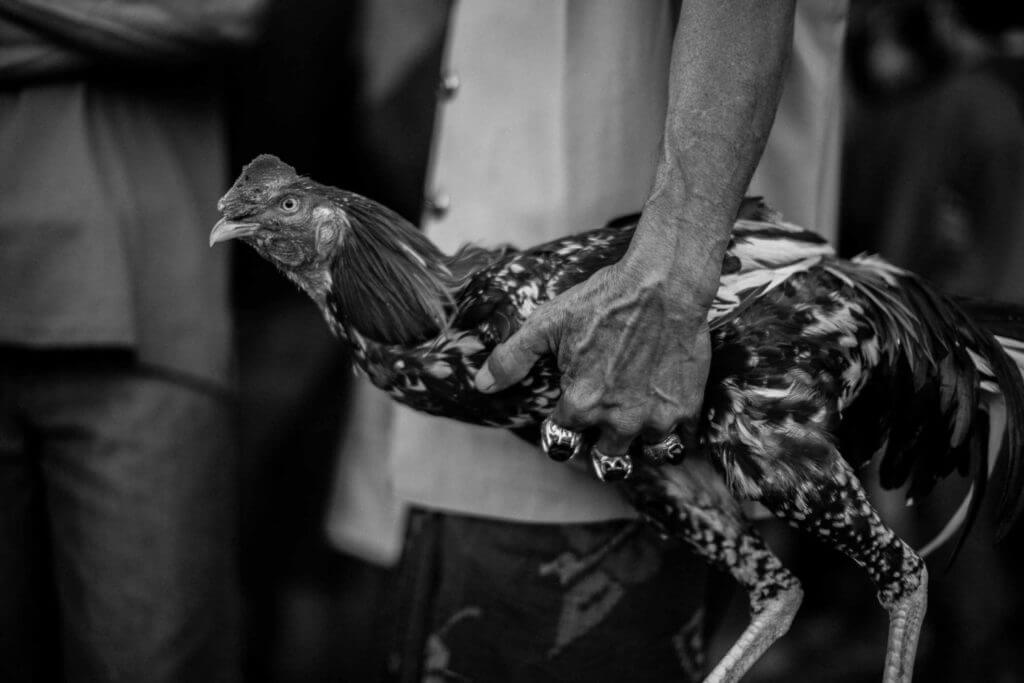
There is great excitement all over Bali at this time, and on the days before nyepi everybody is busy erecting altars for the offerings and scaffolds for the priests at the village crossroads. The celebration extends over a period of two days: the metjaru, the great purification offering, and nyepi, the day of silence. On the first day the Government allows unrestricted gambling and cockfighting, an essential part of the ceremony, because the land is cured by spilling blood over impure earth.
The Tabuh Rah – Ritual – Spilling blood
The Tabuh Rah- The spilling of blood to the earth is needed to expel Bhuta, because their blood is believed to appease the bad natur spirits, so they don’t disturb people, but eventually this ritual is shifted to become entertainment.
There are ancient texts disclosing that the ritual has existed for centuries. It is mentioned in the Batur Bang Inscriptions I from the year 933 and the Batuan Inscription from the year 944 – Balinese calendar. The blood of the loser spills on the ground, an offering to the evil spirits. Three cockfights are necessary for this purpose. Ritual fights usually take place outside the temple and follow an ancient and complex ritual. Only men participate. Women do not even watch.
A cockfight is an offering, a sacred matter. The rules are written down also in the ancient lontar palm books, which are village heirlooms. Before the cockfight begins, a pemangku priest will present offerings to the nature spirits and also the gods.
Spilled blood is also considered a sacrifice that will bring good crops. Animist beliefs extend to the rooster and the cockfight,
”a popular form of fertility worship among almost all Southeast Asians”.
Human Sacrifices – Purusha Medha – Nara Bali – Spilling human blood
“Purusha” and “Nara” = “man/human”
“Medha” and “Bali” = “sacrifice”
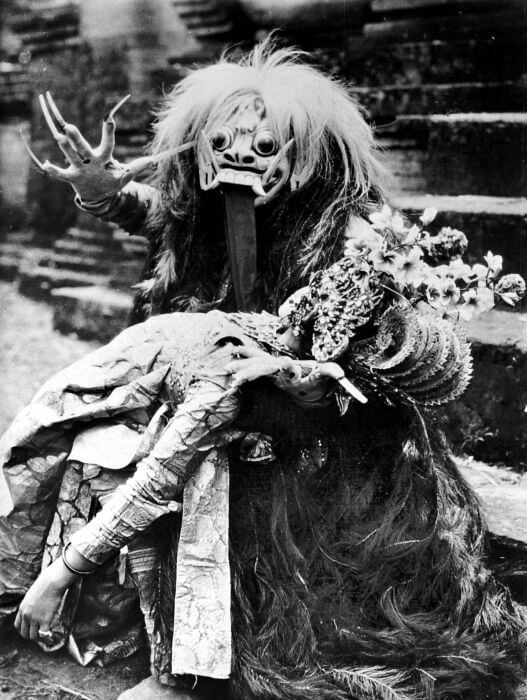
Sacrifice is at the core of Balinese beliefs. Though they enjoy a reputation for gentleness and compassion, islanders immolated multiple young women on pyres as recently as a century ago. A Balinese king told one early Westerner, as many as 140 women would be taken by the flames when he die…
~ Lawler Andrew.
Human blood is still used in some rituals in villages of eastern Bali, where it is drawn using a dagger, sharpened rattan sticks, or thorny leaves.
Usually when blood sacrifice is mentioned it refers to the blood of an animal, as suggested by the term bali (that is, offerings of flesh and blood). The focus today is on animal sacrifice.
Chapters 67 through 78 of the Rudhiradhyaya (Kalika Purana) which discusses bali (bali dhana) and of Vamacara Tantrism.
The Rudhiradhyaya section is notable for its uncommon discussion of human sacrifice. The text states that a human sacrifice may be performed to please the goddess Kalika, but only with the consent of prince before a war or cases of imminent danger.
The text also states that anyone who is physically handicapped, related to a Brahmin, or “is not willing to die” through the sacrifice is unfit for the ritual. The text describes the rituals associated with a bali, or a rice-paste substitute for enemies prior to a war, but does not describe how the sacrifice was actually done.
The flesh of the antelope and the rhinoceros give my beloved (i.e. the goddess Kali) delight for 500 years. By a human sacri fice, attended by the forms laid down, Devi is pleased 1000 years ; and by a sacrifice of three men, 100,000 years.
By human flesh, Camachya, Chandica, and Bhairava, who assume my shape, are pleased 1000 years.
An oblation of blood which has been rendered pure by holy tests, is equal to ambrosia;
the head and flesh also afford much delight to the goddess Chandica.
Blood drawn from the offerer’s own body is looked upon as a proper oblation to the goddess Chandica.
Let the sacrificer repeat the word Kali twice, then the words Devi -Bajreswari, then Lauha Dandayai, Namah !
which words may be rendered
Hail, Kali! Kali!
Hail, Devi!
Goddess of thunder Hail,
iron-sceptred goddess!
Let him then take the axe in his hand and again make the same by the Calratriya text.’
Kali Keil, temples of Kali, are scattered over Carnatic [Karnataka- India], and by tradition a human sacrifice was made at the foundation of each of them.
~ Taylor; Cole. Myth. Iliad. ; From “Cyclopedia of India and of Eastern and Southern Asia” by Edward Balfour (1885)
I do not want to think about the many Pura dalem there are in Bali…
Pur Dalem is a type of pura (temple) dedicated to the worship of Shiva, Durga, Mother nature, Banaspatiraja (barong), Sang Bhuta Diyu, Sang Bhuta Garwa, and other deities, Usually Shiva’s shakti, Durga, is venerated in this temple. In human life cycle, the temple is connected to rituals concerning death. It is also common for a pura dalem to have a big tree like a banyan tree or a kepuh which is usually also used as a shrine. The Pura Dalem is typically located next to the graveyard of the deceased prior to ngaben (cremation) ceremony.
While some self-sacrificial rituals are there in Hinduism and still practiced by devotees during different rituals in different regions; such as tongue piercing by long and sharp needles; hooking and lifting by sharp hooks and ropes; fire walking etc. Here the sufferings of the performer are dedicated to the God in order to wash away their sins.
The œlokas [a pair of verse lines] of Manusmriti [ translated as “The Laws of Manu” or “The Institutions of Manu,” is the most important and authoritative Hindu Law Book (Dharmashastra] referred to by the Hindus in Bali as a comprehensive resource in the use of animals as a means of ritual are those of Manusmriti
V.31, 39, 40 as follows:
The eating of flesh on the occasion of a religious sacrifice is the divine ordination, while to eat flesh for any other purpose is a monstrous practice (31).
For the purposes of religious sacrifices the beasts were created by the self-origined one, the sacrifice is for the elevation of the whole universe; hence, killing is not killing in a religious sacrifice (Yajña) (39).
Cereals, beasts, trees, animals of the tortoise species and birds, immolated onthe occasion of a religious sacrifice, obtain the eternal status (40)
As has been stated in the œlokas above, the use of meat is something natural for the sake of sacrifice. It is expressed as the regulations made and established bygods. But the use of meat beyond the ritual purpose is regarded as the most suitable for ogres. Furthermore, the œlokas above also explain that Svayambhu has created animals for sacrificial purposes. Sacrificial ritual is considered the goodness of the whole of nature. On that account, the slaughter of animals for the purpose of ritualdoes not mean in the ordinary context. Similarly, the œlokas also guarantee the animals and plants slaughtered for ritual sacrifices (yajña) will receive the highest position in the next reincarnation.
Still animal sacrifice is both recommended and criticized in Hindu scriptures:
Animal sacrifice is allowed in Hindu scripture for people with clean minds. Otherwise vegetable sacrifice is to be done as can be seen by the following quote:
One who is of such a cleansed soul may slaughter a cow (as an offering in Sacrifice). They, therefore, that are not of that kind should perform Sacrifices with herbs and plants (and not animals).
Mahabharata Santi Parva Section CCLXIII
Animal sacrifice has also been condemned in Hindu scripture:
How can one like me worship his maker in animal-sacrifices involving cruelty, or sacrifices of the body, such as Pisachas only can perform and such as produce fruits that are transitory?
Mahabharata Santi Parva Section CLXXV
There is no uniform attitude regarding animal sacrifice. Some do it and others are against it.
Animal sacrifice in World Religions
The concept of animal sacrifice is very prominent in the scriptures and rituals of all major religions.
The Christian Bible has a detailed list of which animals can be sacrificed and how they are to be offered.
God commanded Abraham to take his son to Mount Moriah and offer him as a sacrifice. This was God’s test of Abraham’s faith. Abraham loved his son very much, but did not hesitate to follow God’s words. When Abraham and his son reached the place where the sacrifice was to be performed, Isaac said to his father, “Father, where is the lamb that is to be sacrificed?” Abraham replied, “My son, God will provide the lamb.” Eventually, Abraham told his son that he was to be the sacrifice, but Isaac courageously laid on the sacrificial place, ready to be sacrificed for God. As Abraham took out his knife, his hands trembling, when he heard the voice of God saying, “Abraham, stop! Do not hurt your son. You have proven your faith and shown how much you love me. Therefore, you may sacrifice a goat instead.”
Islam knows animals sacrifice, too. Muslims planning to make the trip to the Hajj are obliged to sacrifice a lamb or goat, or join others in sacrificing a cow or camel during the Eid al-Adha festival. Other Muslims not going on the Hajj are also encouraged to participate in this sacrifice so as to share in the sanctity of the occasion. It is understood to be a symbolic re-enactment of Abraham’s sacrifice of a ram in place of his son. This story is known as the Akedah in Judaism (Binding of Isaac) and is also found in the Tora, the first book of Moses (Genesis, Ch. 22).
The Quran refers to the Akedah as follows:
100 “O my Lord! Grant me a righteous (son)!” 101 So We gave him the good news of a boy ready to suffer and forbear. 102 Then, when (the son) reached (the age of) (serious) work with him, he said: “O my son! I see in vision that I offer thee in sacrifice: Now see what is thy view!” (The son) said: “O my father! Do as thou art commanded: thou will find me, if Allah so wills one practising Patience and Constancy!” 103 So when they had both submitted their wills (to Allah), and he had laid him prostrate on his forehead (for sacrifice), 104 We called out to him “O Abraham! 105 “Thou hast already fulfilled the vision!” – thus indeed do We reward those who do right. 106 For this was obviously a trial– 107 And We ransomed him with a momentous sacrifice: 108 And We left (this blessing) for him among generations (to come) in later times: 109 “Peace and salutation to Abraham!” 110 Thus indeed do We reward those who do right. 111 For he was one of our believing Servants. 112 And We gave him the good news of Isaac – a prophet – one of the Righteous.
~ Quran, sura 37 (As-Saaffat), ayat 100–112
In Judaism, the qorban is any of a variety of sacrificial offerings described and commanded in the Torah. The most common usages are animal sacrifice (zevah זֶבַח), zevah shelamim (the peace offering) and olah (the “holocaust” or burnt offering). A qorban was an animal sacrifice, such as a bull, sheep, goat, or a dove that underwent shechita (Jewish ritual slaughter). Sacrifices could also consist grain, meal, wine, or incense.
Animal sacrifice is regularly practiced in traditional African and Afro-American religions.
Buddhism and Taoism generally prohibit killing of animals, some animal offerings, such as fowl, pigs, goats, fish, or other livestock, are accepted in some Taoism sects and beliefs in Chinese folk religion.
We would like it to be known, that in no way do we condone cruelty to animals or endorse acts of violence towards animals.
~ ○ ~
Keep exploring:
Works Cited & Multimedia Sources
- Animal Sacrifice in Bali-Hindu’s Rituals. https://web.archive.org/web/20241212002527/https://ubudcommunity.com/animal-sacrifice-in-bali-hindus-rituals/
- Animal Sacrifice. https://en.wikipedia.org/wiki/Animal_sacrifice
- Balfour Edward. Cyclopedia of India and of Eastern and Southern Asia. 1885.
- Food of Bali Ritual. The Bali Times. 2015. http://www.thebalitimes.com/2015/11/02/food-of-bali-ritual/
- Bandyopadhyay Indrajit.Variations in Indonesian Mahabharata.
- Bhuyan Rashmi Rekha. The Portrait of the Goddess in the Kalika Purana. In: IOSR Journal Of Humanities And Social Science. Volume 22, Issue 10, Ver. VII. 2017. www.iosrjournals.org
- Donder I Ketut, in The essence of animal sacrifice in Balinese Hindu ritual: Discourse around Theological, Philosophical, Mythological, Ritual and Scientific Phenomena. 2012.
- Eid_al-Adha. https://en.wikipedia.org/wiki/Eid_al-Adha
- Francine Brinkgreve. Offerings to Durga and Pretiwi in Bali. 1997.
- Fuller, C. J. The Camphor Flame: Popular Hinduism and Society in India. Revised and Expanded Edition. Princeton: Princeton University Press. 2004.
- Geertz, Clifford. “Notes on the Balinese Cockfight” in The Interpretation of Cultures, Basic Books, 1973.
- Hooykaas C. Religion in Bali. and Cosmogony and creation in Balinese tradition.The Hague: Martinus Nijhoff. http://www.cimande.com/silat/documents/four-brothers/book.pdf
- Hymn to Kali. Arthur Avalon (Sir John George Woodroffe), 1922. sacred-texts.com
- Jenn George. Hinduism in Indonesi.Balinese Hinduism. 2015. https://web.archive.org/web/20230322093215/http://www.mahavidya.ca/2015/03/10/balinese-hinduism/
- Kalika Purana With English Translation ( Introduction, Index Missing) OPT” Kalika Purana in english is not on archive org any more, sadly.
- Kalika Purana. https://www.wikiwand.com/en/Kalika_Purana
- Lawler Andrew. Why Did the Chicken Cross the World?: The Epic Saga of the Bird that Powers Civilization. 2016.
- Magee Michael. The Magic of Kali. Inner Secrets of a Tantrik Goddess. 1995.
- Mahabharata – Sacred Texts. http://www.sacred-texts.com/hin/maha/
- Michele Stephen. Returning to Original Form A Central Dynamic in Balinese Ritual. In: Bijdragen tot de Taal-, Land- en Volkenkunde 158. 2002.
- Ngurah, Anom R. I. G. The civic realm in Bali: a case study of ritual traditions in the Littoral regions. Doctoral thesis. 2017. http://eprints.hud.ac.uk/id/eprint/32101
- Rajiv Malik. The Reality of Animal Sacrifice. This controversial practice is widely accepted in Bali, Nepal and a handful of other places. Opinions on its basis and morality differ throughout the Hindu world. https://www.hinduismtoday.com/modules/smartsection/item.php?itemid=5262
- Some Uses of Animals in Hinduism, To Fill Oblations and Caru Rituals. https://web.archive.org/web/20170817162113/http://bali-travelnews.com:80/2017/08/10/some-uses-of-animals-in-hinduism-to-fill-oblations-and-caru-rituals/
- The Island Of Bali, Indonesia. Rites and festivals. Gods and Demons: Offerings and Exorcisms. Indo-leisure.com
- The Song Celestial; Or, Bhagavad-Gîtâ (from the Mahâbhârata) by Sir Edwin Arnold: http://www.gutenberg.org/ebooks/2388
- Variations in Indonesian Mahabharata. https://sobokartti.wordpress.com/2009/11/19/variations-in-indonesian-mahabharata/
- Read more about animal sacrifice in Hinduism, evidences from scriptures here https://www.dawahmaterials.com/answering-hindus/144-human-sacrifices-and-cannibalism-in-hinduism
- Read more about human sacrifice in Hinduism, evidences from scriptures here: https://www.dawahmaterials.com/answering-hindus/144-human-sacrifices-and-cannibalism-in-hinduism
